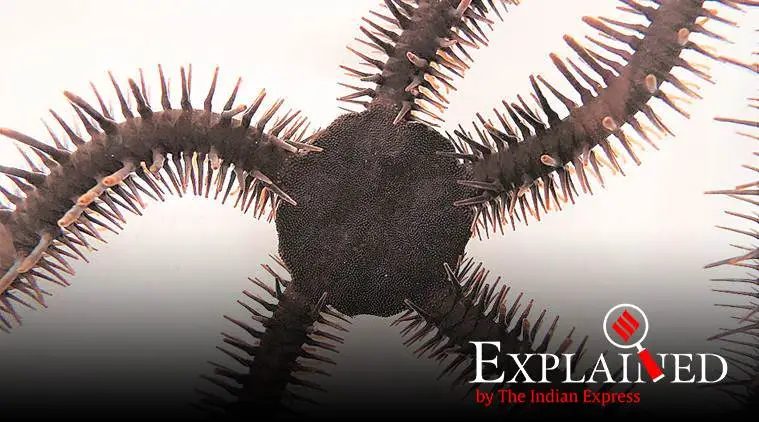Explained: What is Extraocular Vision
The ability to ‘see’ without eyes. How does the red brittle star manage it?
 Red brittle star, Ophiocoma wendtii. Lauren Sumner-Rooney/University of Oxford
Red brittle star, Ophiocoma wendtii. Lauren Sumner-Rooney/University of Oxford
For the first time, researchers have shown that a species of brittle stars, which are relatives of starfish, can see even though it does not have eyes. The red brittle star (Ophiocoma wendtii), which lives in the coral reefs of the Caribbean Sea, becomes only the second creature, after a sea urchin species, known to have this ability (barring freak cases in other species).
The ability to see without eyes is known as extraocular vision. Previous researchers have defined it as the ability to resolve scenes without discrete eyes. In 1966 Dr L Chertok of the Cochin Hospital wrote about the case of one Rosa Koulechova in Soviet Union who was able to “see” colours with her fingers. Chertok wrote that many thought the explanation for extraocular vision was to be found in the photo-sensitivity of the skin.
In sea urchins and brittle stars, researchers suspect that extraocular vision is facilitated by the photoreceptor cells found on their bodies. Scientists from the University of Oxford, who have published their findings in Current Biology, placed brittle stars in a circular arena in the laboratory. The brittle stars moved toward walls that were white with a black bar, suggestive of a daytime hiding place. When grey walls were included, they still moved towards the black stripe, which was centred on a white stripe.
The researchers suggest that a brittle star sees with the help of light-sensing cells that cover its entire body. These light-sensing cells give the brittle star visual stimuli, allowing it to recognise coarse structures such as rocks, the research suggests.
Another peculiar feature of the red brittle star is its signature colour change. While the creature is deep red during the day, it changes its colour to beige at night. The researchers think that there may be a link between their extraocular vision and colour changing abilities since the responses they saw in the creatures tested during the day, disappeared in those that were tested at night.
“It’s a very exciting discovery. It had been suggested 30 years ago that changing colour might hold the key to light-sensitivity in Ophiocoma, so we’re very happy to be able to fill in some of the gaps that remained and describe this new mechanism,” Lauren Sumner-Rooney, a research fellow at Oxford University Museum of Natural History who studies unusual visual systems, said in a statement released by the university.
- 01
- 02
- 03
- 04
- 05






































